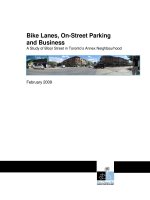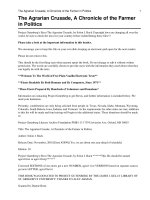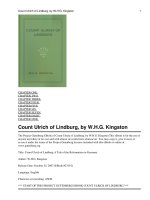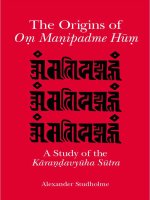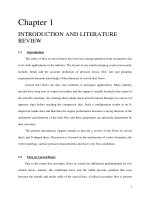A study of the flow in an s shaped duct 4
Bạn đang xem bản rút gọn của tài liệu. Xem và tải ngay bản đầy đủ của tài liệu tại đây (80.23 KB, 12 trang )
47
Chapter 4
♠
SWIRL DEVELOPMENT IN SQUARE
CROSS SECTIONED S-SHAPED DUCT
4.1 Introduction
As discussed in the Chapter 3, curved duct flows are influenced predominately by two
related forces, namely, the centrifugal force and the radial pressure gradient force that exist
between the outside and inside walls of the curved duct, resulting in the formation of
secondary flow. In that chapter, a non-dimensional parameter , defined as the ratio of radial
pressure gradient to centrifugal force, was established and its relation with C
p
and curvature
ratio was shown explicitly. The variation of (s/S
O
) with normalised downstream distance,
(s/S
O
) results in collapsed curves independent of curvature ratio. Using the data from square
cross-sectioned S-shaped duct, it was also shown that data scatter in the collapsed curved was
attributed to differences in inlet condition, the presence of flow separation and stream wise
vortices. In this Chapter, the swirl development of square cross sectioned S-shaped duct is
investigated in more detail, with attention focused on the formation mechanism of these
stream-wise vortices in the second bend of the S-duct and to propose a simple flow model to
clearly show the vortical flow topology.
♠
A major part of this chapter has been published in Experiments in Fluids (2006, Vol. 41 Issue: 6 pp 975-
989) under the title “On swirl development in a square cross-sectioned, S-shaped duct” by Ng YT, Luo SC, Lim
TT, and Ho QW.
48
4.2 Experimental Set-up and Methodology
As described in detail in Chapter 2, the investigations here were conducted at U
m
= 5
m/s and 15 m/s with corresponding Re = 4.73x10
4
and 1.47x10
5
, respectively. Using three
square cross-sectioned, S-shaped ducts (termed TS 1 to TS 3) with curvature ratio R
C
/D =
2.422, 1.933 and 1.667, and a duct turning angle =33.4
O
, 43.6
O
and 53.1
O
, respectively. The
inlet boundary layer thickness, measured using a single hot-wire at a flow speed of 15 m/s,
was 7.5 mm (or 0.05D).
The side wall C
p
was measured using the Scanivalve system and the total pressure and
cross flow velocity at the S-duct’s exit were measured using Pitot-static tube, and cross-hot
wire respectively. A single hot wire was also used to measure the turbulence intensity at the
S-duct’s exit. The probes were mounted on the linear traversing device, and the spatial
resolution for all probe measurements is 5 mm. In all cases, a 5 sec waiting time was allowed
for the flow to stabilise before acquiring data at each new probe position. For total pressure
and single wire measurement, the entire exit plane was measured while for cross wire
measurements, only the lower half plane was surveyed.
Smoke wire visualization was used to visualize the flow separation phenomenon.
Vertical wire smoke visualization was used close to the near-side wall in the first bend of the
S-duct to visualize the flow near that wall due to swirl development in the first bend. Finally,
surface flow visualization on the entire bottom wall of the S-duct was also conducted to give
an overall picture of swirl development in the duct.
4.3 Results and Discussion
4.3.1 Side wall C
p
distribution
The data for side wall C
p
distribution and flow visualization were presented in
Chapter 3.3.1, and they are repeated here to aid further discussion. Fig. 4.1(a) to 4.1(c) shows
49
the side wall C
P
distribution versus s/D (where s is measured from the center of the duct inlet
plane along the curved duct centerline), for the three S-shaped test sections investigated. In
all cases, the C
P
distribution on the near and far-side wall displayed a general sinusoidal-like
variation, and the pressure difference between the two side walls increases with the duct
curvature. In addition, all the three pressure distributions of the near-side wall display an
inflection point, which indicates the presence of flow separation. This was confirmed by
smoke wire flow visualization near the separation point as shown in Fig. 4.2(a) to (c) for Test
Section 1 to 3, respectively. This clearly shows that the presence of flow separation led to a
local distortion of the C
P
distribution on the near-side wall resulting in the inflection point.
The strong adverse pressure gradient due to the high curvature side wall in the duct led to
flow separation along the near-side wall. The adverse pressure gradient is defined in the
present investigation as the difference between the minimum near-side wall pressure and the
pressure at the inflection point for each test section. Denoting the adverse pressure gradient
along the near side wall for the three test sections as
'
1
s
C
p
∆
∆
,
'
2
s
C
p
∆
∆
and
'
3
s
C
p
∆
∆
as
shown in Fig. 4.1(a) to (c) respectively, and together with s
’
= s/D, which is the
curvilinear distance taken over the two end points in the adverse pressure gradient region, the
estimated magnitudes of
'
1
s
C
p
∆
∆
= 0.2053,
'
2
s
C
p
∆
∆
= 0.2878 and
'
3
s
C
p
∆
∆
= 0.3748.
Expectedly, this shows that the increase in curvature leads to a corresponding increase in the
magnitude of the adverse pressure gradient.
In addition to the presence of flow separation, the side wall pressure distribution
clearly shows that the pressure difference between the near and far side walls changes sign
along the axial flow direction of the S-duct. Compared to the works of Anderson et al. (1982)
and Taylor et al. (1982a) on the gentle curvature S-shaped duct of R
C
/D = 7.0, it is quite well
known that swirling flow develops in the first bend and the direction of swirl is largely
50
reversed after the second bend, due to both the change in curvature and the change in sign of
the pressure difference between the two side walls. Therefore, the present surface pressure
measurements are consistent with those reported in the literature. In the present study, where
the ducts have sharper curvature than those reported in literature, surface oil flow
visualization on the bottom floor of the duct and smoke wire flow visualization on the near-
side wall of all the three S-duct test sections were conducted to better understand the flow and
the swirl development. This is discussed in the next section.
4.3.2 Surface and Smoke Flow Visualization
Fig. 4.3(a) to (c) show the surface oil flow patterns at the bottom floor of Test Section
1 to 3 respectively. All three test sections show the distinctive feature of a dividing line
(where the white powder is accumulated) that emanates from the end of the first bend at the
near-side wall, and leaves the duct exit close to the far-side wall of the second bend. The
presence of this line marks two flow regions denoted as region A and B in the figures. On
closer inspection of the streaks in region A in Fig. 4.3(a) to (c), it is noted that the flow, upon
entering the first bend, develops a swirl such that the flow component, next to the bottom
floor, moves from the far-side wall to the near-side wall. However, on entering the second
bend, a reversal of swirl direction begins, which can be seen from the streaks in region B. In
addition, the streaks in region A in the second bend, moves from the near-side wall to the far-
side wall. The existence of this dividing line, which arises due to the swirling flows of
opposite direction, was not previously reported in the literature.
To complement the surface flow visualization study and provide more insight to swirl
development in S-duct flows, smoke wire flow visualization on the near-side wall was also
conducted. As pointed out in Chapter 2.7, a vertical smoke wire was placed upstream of the
inflection plane and close to the near-side wall of the S-duct. Due to flow symmetry about the
51
mid-plane of the S-duct (the z/D = 0.0 plane), the flow visualization was conducted for the
upper half of the near-side wall only, and the results are shown in Fig. 4.4(a) to (c) for Test
Section 1 to 3, respectively. Of interest is the change in flow direction of the smoke trails
especially those near the top wall of each test section. In all cases, it can be seen that the
smoke trails near the top wall exhibit an initially downward trajectory before turning upward.
Although not visualized, it can be conjectured that the smoke trail at the bottom half of the
test section, will follow an initially upward trajectory before turning downward, essentially a
mirror image trend. The change in direction of the smoke trails is due to the change in swirl
directions, close to the near-side wall, as the smoke is convected from region A into B as
labeled in Fig. 4.3(a) to (c).
In addition to the flow visualization study, which provides a qualitative understanding
of the swirl development in a square cross-sectioned S-duct, total pressure distribution and
cross flow velocity measurements at the S-duct exit were also conducted to obtain a
quantitative appreciation of the flow features. The results are discussed in the next section.
4.3.3 Total Pressure Distribution and Cross Flow Velocity
The data for total pressure distribution and cross flow velocity had been presented in
Chapter 3.3.3 and are repeated here for convenience of further discussion and presentation.
Fig. 4.5(a) to (c) show the total pressure distribution (using a Pitot-static tube) and the
normalized cross flow velocity (using a cross hot-wire) at the S-duct exit for Test Section 1 to
3, respectively. The Reynolds number was Re = 1.47x10
5
. In these Figures, the s-y-z
coordinate axes are adopted, and Fig. 4.5 is plotted with the positive s-axis (the exit flow
direction) pointed out of page, positive y-axis pointed to the right and positive z-axis pointed
upwards. On a more general note, the figures show that in all three test sections, the exit total
pressure distributions are fairly symmetrical about the z/D = 0.0 plane and the regions close
52
to the four surrounding walls have relatively lower total pressure (and exit velocity) than
those in the core. Furthermore, the normalized cross flow vector plots showed generally that
in the central region of the duct, the main bulk of the cross flow is from the far-side wall to
the near-side wall while the cross flow near the bottom floor of the test section is in the
opposite direction. The cross flow thus sets up a swirl at the duct exit, in the lower half of the
duct exit plane.
With the combined normalized cross flow vector plots in Fig. 4.5(a) to (c) and the
surface oil flow visualization in Fig. 4.3(a) to (c), the swirl developments in Test Section 1 to
3 can be studied in more detail. By comparing the respective results from Figs. 4.3 and 4.5,
one can deduce that the location of flow reversal on the bottom floor of the S-duct (in Fig.
4.5) corresponds approximately to the location of the dividing line near the S-duct exit (in
Fig. 4.3). The oil streaks in region B of Fig. 4.3(a) to (c) indicate the existence of a cross flow
velocity component near the bottom wall of the S-duct, which is directed from the near-side
wall to the far-side wall. This observation is supported by the cross-wires measurements
shown in Fig. 4.5(a) to (c). Since the oil streaks in region A are directed from the far-side
wall to the near-side wall, it can thus be said that close to the bottom floor of the test section,
the flow in region A and B meet and subsequently separate along the dividing line. Hence,
this dividing line is actually a flow separation line, resulted from the “meeting” of swirling
flows of opposite direction.
The overall flow behavior can be seen more clearly in a 3-D flow model presented in
Fig. 4.6 for the lower half of a typical square cross-sectioned, S-shaped duct. It is expected
that the upper half would behave in a similar but mirror image way. It can be seen in Fig. 4.6
in the flow model that the flow develops a swirl (in Region A) after passing through the first
bend of the S-duct, while in the second bend of the duct, the swirl of the opposite direction
(in Region B) develops near the inflection plane of the duct, close to the near-side wall.
53
While the swirl in Region B grows in size and strength due to the S-duct’s curvature in the
second bend and the increasing transverse pressure gradient, the swirl in region A undergoes
a corresponding decrease in size as it approaches the duct exit. The two swirling flows of
opposite direction meet along a dividing or separation line as shown in Fig. 4.6, which is
consistent with the surface oil flow visualization presented in Fig. 4.3(a) to (c). In addition,
the 3-D flow model is in agreement with the vertical smoke wire flow visualization presented
in Fig. 4.4. As noted and discussed previously, the smoke trails close to the near-side wall on
the lower half of the S-duct followed an initially upward trajectory before turning downward
as the smoke crosses the dividing line. This observation is also reflected in the flow model in
Fig. 4.6(b), and is labeled as C, near the entrance to the inflection plane of the duct and close
to the near side wall. Just upstream of C (in the first bend of the S-duct), the flow carries the
smoke in an upward trajectory away from the bottom wall. However, upon entering the
second bend and crossing the dividing line close to the near-side wall, the smoke trails follow
a downward path towards the bottom wall. Hence, the change in the direction of the smoke
trails is a manifestation of the change in swirl direction. From Fig. 4.5(a) to (c), the
normalized cross flow vector plots show that stream-wise vortices are present close to the
near-side wall of the S-duct, and they exist either as a counter rotating vortex pair or as just a
single vortex. For illustration purposes, the presence of stream-wise vortices along the near-
side wall of the second bend is also illustrated in Fig. 4.6 as a counter-rotating vortex pair.
The formation mechanism for these stream-wise vortices is quite different from that of the
swirl development discussed earlier.
It should be noted that these stream-wise vortical structures were also observed in the
experimental work of Anderson et al.(1982), Taylor et al. (1982a) and the numerical work of
Sugiyama et al.(1997) (in Japanese). Using an S-duct with curvature ratio R
C
/D = 7.0, duct
turning angle
= 22.5
O
and Re = 4.0x10
4
, they found only a single vortex at the near-side
54
wall of the second bend and showed that the axial vorticity developed in the first bend is
locally reinforced at the near-side wall of the second bend. Anderson et al. (1982) and Taylor
et al. (1982a) explained the formation mechanism of such vortices by considering the Squire
and Winter formula (Squire and Winter (1951) and Scorer (1997)) for the production of axial
vorticity from radial vorticity in turning flows. It was shown by Squire and Winter (1951)
that, for flows in a bend, a redistribution of vorticity takes place, such that the axial vorticity
in the direction of flow is equal to the velocity gradient (or
zu ∂∂
) in the approaching stream
multiplied by twice the angle of deflection. That is,
z
u
z
v
r
w
∂
∂
−=
∂
∂
−
∂
∂
ε
2
(4.1)
where u ,v and w = velocity components,
r = the radial co-ordinate directed towards the centre of curvature (same as y
axis at the exit plane of the duct),
z = the vertical co-ordinate and
= the turning angle of a bend measured in radians.
The derivation of the Squire and Winter formula is shown in Appendix A and B of
this thesis. To test whether the Squire and Winter formula is applicable in the present work,
which was conducted at a Re = 1.47x10
5
and with S-shaped ducts of sharper curvature,
zu ∂∂
was deduced from the velocity measurements from a single hot wire and this is shown
in Fig. 4.7(a) and (b). In Fig. 4.5(a) and (b), it can be seen that the center of the counter-
rotating vortex pair occurs approximately along the line y/D = -0.4 and from Fig. 4.7(a) and
(b), the rate of change of normalized
zu ∂∂
shows two sign changes as z/D increases for Test
Section 1 and 2. In other words, with increasing z/D along the line y/D = -0.4, normalized
zu ∂∂
is initially positive, and followed by a negative value before turning positive again as
z/D increases. In reference to Eq. 4.1, the sign changes in
zu ∂∂
results in axial vorticity of
55
the opposite sign which is consistent with the counter-rotating vortices seen in Fig. 4.5(a) and
(b). The same argument can be applied to Test section 3 in Fig. 4.7(a) and (b) where
normalized
zu ∂∂
follows a positive and then a negative trend. Here, with only one sign
change, only single vortex is seen in Fig. 4.5(c). The explanation based on Squire and Winter
formula suggests that the initial swirl developed in the first bend of the duct leads to a
redistribution of the stream-wise velocity (or isotachs) close to the near-side wall of the
second bend. This in turn leads to velocity gradients, which results in the formation of
stream-wise vortices.
To further study the influence of swirl on the stream-wise vortices near the wall,
measurements of exit-plane total pressure distribution, normalized stream-wise and cross
flow velocities were repeated for Test section 1, 2 and 3 at a lower Re = 4.73x10
4
(or U
m
= 5
m/s). These results are shown in Fig. 4.8(a) to (c) respectively for the three above mentioned
test sections. Fig. 4.9(a) and (b) shows the changes in normalized
zu ∂∂
for the three test
sections. Fig. 4.8(a) to (c) illustrate that the stream-wise vortices are also present for the low
Re case, in the form of a pair of counter-rotating vortices for Test section 1 and 2 and a single
vortex for Test Section 3. Therefore, for these test sections, the vortex configuration remains
the same as that in the higher Re cases. However, the positions of the vortex cores in these
low Re cases are located closer to the duct centre plane than in the higher Re cases. If the
Squire and Winter formula is applied one at a time to Fig. 4.8(a) along y/D = - 0.35 for Test
Section 1, to Fig. 4. 8(b) along y/D = -0.35 for Test Section 2, and to Fig. 4.8(c) along y/D = -
0.3 for Test Section 3, one notes that the variation of normalized
zu ∂∂
for Test Section 1 and
2 undergoes two sign changes as z/D increases, while for Test Section 3 only a single sign
change is present, as shown in Fig. 4.9(a) to (b). The above illustration thus shows that the
Squire and Winter formula is applicable at both the Reynolds numbers and provides a
qualitative explanation of the formation mechanism of the stream-wise vortices near the wall.
56
In addition, the use of the formula allows one to predict the vortex configuration of these
stream-wise vortices based only on the sign changes in velocity gradient.
4.3.4 Exit Turbulence Intensity
The turbulence intensity at the S-duct exit was measured for Test section 1, 2 and 3
for Re = 1.47x10
5
and Re = 4.73 x 10
4
. The normalized turbulence intensity (u
’
/U
m
)
distribution plots are shown in Fig. 4.10 for Test Section 1 to 3 at Re = 1.47x10
5
and in Fig.
4.11 for Re = 4.73x10
4
. The turbulence intensity in each figure is normalized by their
respective flow velocities. The two figures showed that the core flow has relatively lower
turbulence intensity (about 3%) than the near wall, low momentum flow region (typical
values of 7% to 12% and above). Comparing Fig. 4.10 with Fig. 4.5 and Fig. 4.11 with Fig.
4.8, it is clear that the near wall vortical regions correspond to regions of relatively high
turbulence intensity. Given the relatively high turbulence intensity, one may question the
applicability of the Squire and Winter formula on explaining the formation mechanism of the
near wall longitudinal vortices. This can be addressed by looking at the data from Taylor et
al. (1982a). In their work, Taylor et al. (1982a) performed an investigation at a low Re = 790
(laminar case) and at comparatively higher Re = 4.0x10
4
(or turbulent case) and reported that
the turbulence intensity for Re = 4.0x10
4
near the wall is 13%. This is in good agreement
with the present data for Re = 4.73x10
4
(typically about 12% and above). The Squire and
Winter formula was applied to the two stated cases and was shown to be applicable to both
laminar and turbulent flow in Taylor et al.’s work. Even though the turbulence intensity in
their work is relatively high near the wall (about 13%) for Re = 4.0x10
4
, the Squire and
Winter formula can still explain the formation of the stream-wise vortices. In the present
investigation, the Squire and Winter formula also correctly predicted the number of stream-
wise vortices. Hence it can be argued that the Squire and Winter formula can be extended to
57
the present flow cases. Taylor et al. (1982a) explained that the primary factor which affects
the swirl development and vortical flow structure in the S-duct is actually the inlet boundary
layer thickness. From their result and discussion, it seems that turbulence intensity has less
influence on the applicability of the Squire and Winter formula. In the next Chapter, the inlet
boundary layer thickness is varied to study its effects on the configuration of these stream-
wise vortices. In addition, the cross flow on multiple, internal planes of the S-duct will be
presented to verify the flow model proposed in this Chapter.
4.4 Chapter Conclusion
The flow features in square cross sectioned S-shaped ducts of large curvature and at
Re = 4.73x10
4
and 1.47x10
5
have been investigated experimentally in detail. Surface pressure
measurements and flow visualization indicated the presence of flow separation at the near-
side wall of the first bend. The swirl flow, which developed in the first bend, was largely
attenuated in magnitude in the second bend due to the formation of swirl flow of the opposite
direction. Surface oil flow visualization conducted on the bottom wall showed the existence
of a clear dividing or separation line, with a similar separation line expected to occur on the
top wall due to symmetry of the S-duct test section. This separation line is caused by the flow
of opposite swirl which meet, and subsequently separate along this line. In addition, stream-
wise vortices were found to form, either as a counter-rotating vortex pair or just a single
vortex, along the near-side wall at the second bend. Their formation follows the mechanism
suggested by Squire and Winter (1951), and can be traced to the redistribution of stream-wise
isotachs which led to velocity gradient
zu ∂∂
. The redistribution of isotachs is shown to be a
predominately invicid process.
In addition, a qualitative flow model has been proposed here. In the next Chapter,
cross flow velocity and total pressure measurements at multiple planes inside the S-duct will
58
provide a clearer picture of the proposed flow model. Furthermore, the effects of inlet
boundary layer thickness will be investigated for square cross sectioned S-duct flows, which
will provide further explanation on the formation of stream-wise vortices along the curved
wall of the second bend.



